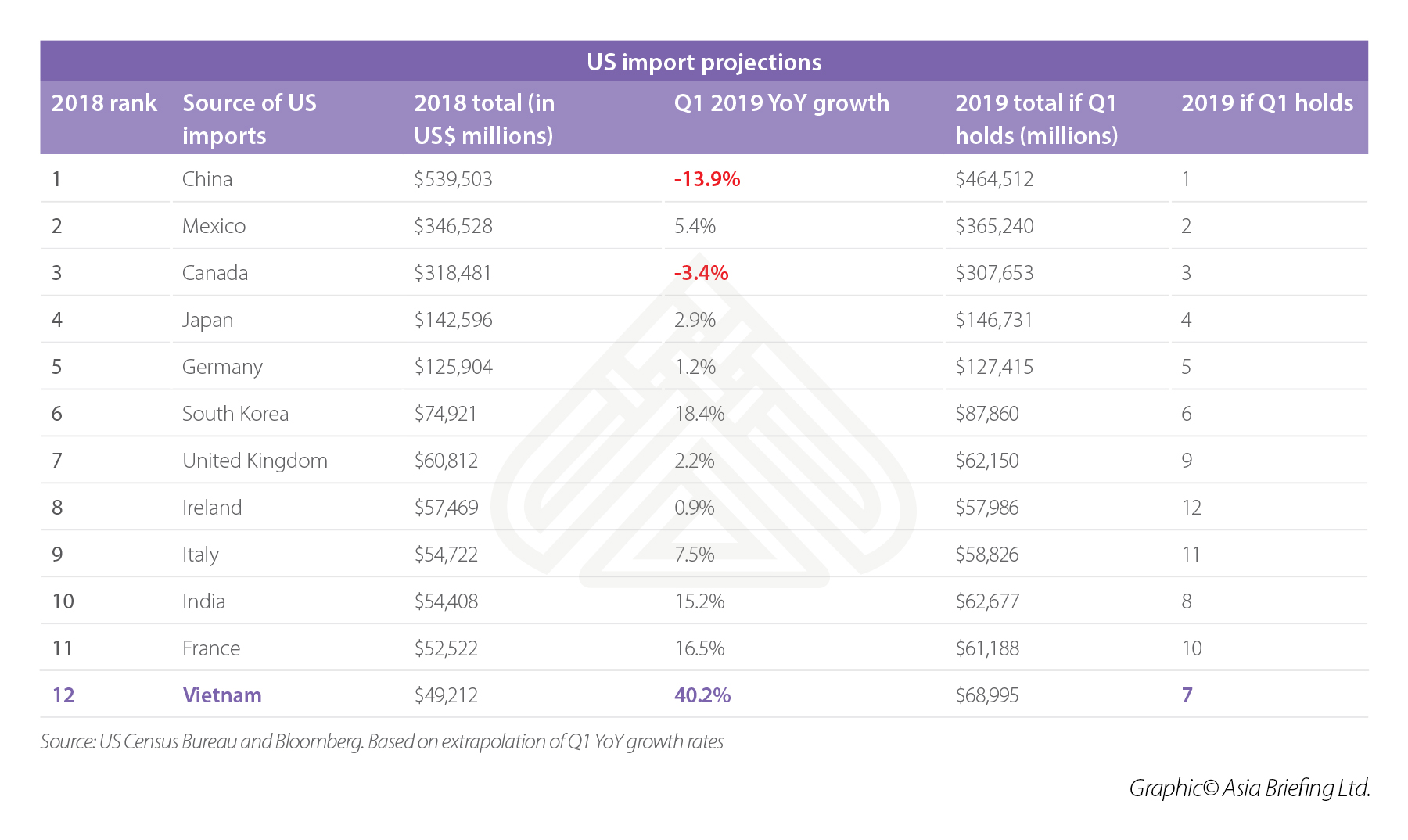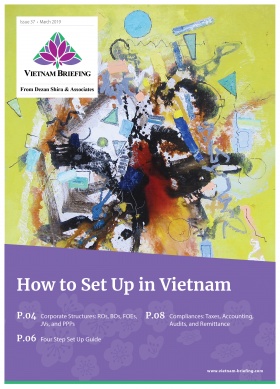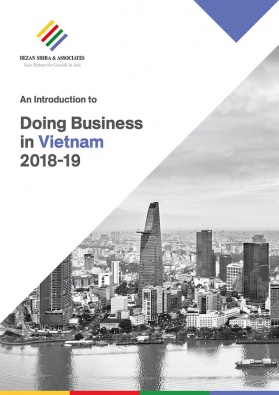FDI in Vietnam – Where is the Investment Going?
Fueled by continuous growth, Vietnam continues to attract record foreign direct investment (FDI). The latest data from the Foreign Investment Agency (FIA) shows that FDI in Vietnam in 2019 reached US$38.2 billion an increase of 7.2 percent as compared to the same period in 2018.
Around 3,883 new projects were licensed with a total registered capital of US$362.5 billion in 2019. In 2019, foreign direct investment projects were estimated to disburse 20.38 billion USD, up 6.7 percent as compared to the same period in 2018.
Out of 19 sectors receiving capital, manufacturing and processing came on top with total capital of US$24.56 billion, accounting for 65 percent of total registered investment capital. This was followed by real estate at US$3.88 billion and then by retail and wholesale.
Investment has been mainly driven by the US-China trade war.
Aside from this, Vietnam is committed to an ambitious investment plan to develop overall infrastructure in major industrial poles in the country, which will ease doing business and improve logistics.
This, coupled with the recent entry into force of the Comprehensive and Progressive Agreement for Trans-Pacific Partnership (CPTPP) and the EU and Vietnam FTA (EVFTA) (expected to be officially approved in June) will provide significant opportunities for both inbound and outbound investment for the next few years.
Furthermore, it is likely that Vietnam will continue improving its legal framework to adhere to transparency requirements imposed by the aforementioned agreements, especially in relation to Intellectual Property Rights (IPR) protection.
Sources of investment diversifying
Asian countries represent the lion’s share of FDI into Vietnam.
In 2019, South Korea was the top investor in Vietnam investing US$7.9 billion, followed by Hong Kong at US$7.8 billion. In the first 11 months of 2019, the largest pledged FDI also came from Hong Kong.
An important point to note is that China has been increasing its investment in Vietnam rapidly. Over the years, it has become the seventh largest investor in Vietnam. In 2018, it moved up to fifth and is now fourth.
This can partly be attributed to the US-China trade war, but some analysts say that China is also pushing investment through Hong Kong as Vietnam becomes more cautious about Chinese investment.
Hanoi retains its title of being the most attractive destination for foreign investors with US$2.78 billion of total FDI registered or 16.6 percent. This is followed by Binh Duong province at US$1.25 billion.
North Vietnam is rapidly consolidating its position as a main industrial hub for the electronics and heavy industry, thanks to the presence of global conglomerates like Samsung, Canon, and Foxconn and for the automotive industry (the first Vietnamese carmaker Vingroup established its factory in Haiphong last year), which are stimulating the development of a reliable supply chain in the area.
The first deep-sea port in North Vietnam, Lach Huyen port, opened its first two terminals, which can accommodate big vessels – thus avoiding stops to Hong Kong and Singapore in international freight transport, saving about one week in shipments.
Binh Duong and Ho Chi Minh City, in South Vietnam, are the main industrial hubs, specializing in textile, leather, footwear, mechanics, electricity and electronics, and wood processing.
South Vietnam has also been the main destination for renewable energy investment projects, in particular solar power plants. In the future, while the southern region will maintain its attractiveness, investments in solar plants is expected to gradually shift to the central and northern areas.
During the Jan-May period, the foreign invested sector produced US$70.4 billion from exports – a five percent year-on-year increase that accounts for 70 percent of the country’s total export turnover. As of May 20, there were 28,632 FDI projects with a total registered capital of US$350.5 billion.
The rise of Vietnamese firms
Vietnamese firms invested nearly US$183 million in 69 projects overseas in the same period, showing that local firms were also becoming more internationally competitive.
This investment focused on science and technology, banking, and the IT sector. Spain, US, and Cambodia attracted the largest share of Vietnamese investment.
In this year’s Forbes Global 2000 list, four Vietnamese firms are named, including Vietcombank, BIDV, Vingroup, and VietinBank – showing just how far Vietnamese businesses have come.
Meanwhile, a recent report by DBS Bank states that Vietnam’s economy could become bigger than Singapore’s by 2029 if it sustains its growth trajectory. Vietnam’s government expected GDP to expand to at least 6.8 percent this year.
Increased exports to US
As the US-China trade war continues, Vietnam has become one of the fastest growing sources of American imports in the first quarter of the year. If this keeps up, Vietnam could surpass the UK as one of the biggest suppliers to the US, according to Bloomberg.
Imports from Vietnam to the US jumped 40.2 percent in the first three months over the same period last year. During the same time American imports of Chinese goods dropped by 13.9 percent.
Three top sectors receiving FDI
According to the FIA report, manufacturing and processing, real estate, as well as retail and wholesale are the top three sectors for FDI in Vietnam.
Manufacturing and processing
Manufacturing and processing continues to account for the major portion of FDI.
Vietnam’s Ministry of Trade sees supporting the industry as key to boosting socio-economic development. The government wants to restructure the industry to support domestic production and increase localization rates.
Industry experts say that Vietnam has benefited due to companies moving manufacturing to Vietnam as costs in China started to increase. The US-China trade war has accelerated the process.
As the sector matures, the stakes for industry players will increase as Vietnam solidifies its position as a manufacturing destination. Challenges remain, with the development of supporting industries lagging – developing supply chains and suppliers are not as easy as in China, while Industry 4.0 concepts are behind larger economies.
However, the government is keen to change this, and the strong growth in the first five months of the year show that concerns are not expected to throw the sector off track.
Filippo Bortoletti, International Business Advisor at Dezan Shira & Associates notes, “the availability of land and industrial workshops is becoming a concern in already developed areas, where higher traffic volumes are also increasing the cost of freight transport by road. In this scenario, investors are starting to look into other areas, such as Da Nang, to expand their manufacturing facilities.”
Furthermore, as numerous investors are tapping into Vietnam, cost of labor is likely to increase. In this scenario, it is paramount that companies implement appropriate retention policies to avoid or mitigate turnover.
Real estate
Vietnam’s real estate market, as in previous years, continues to attract foreign and domestic investors. Increased tourism, and large infrastructure projects, such as the Hanoi and Ho Chi Minh metros projects, are further expected to push demand for real estate.
Flexible workspaces are becoming more and more common in Vietnam in part due to the limited supply of traditional offices in in-demand locations. Several companies such as WeWork, Workyos, Kloud, and CEO Suites have opened co-working spaces as recent as 2018.
Demand is coming from South Korea, Hong Kong, and China. While Hanoi and Ho Chi Minh City boast the highest growth, development is not confined to the main cities.
Tourists spots like Da Nang, Nha Trang, and Phu Quoc island are experiencing growth spurts, with numerous hotels and residential projects under construction. The industry is also seeing strong growth due to the country’s growing middle class.
As per the government’s housing strategy, the average housing area should reach 25 square meters per capita by 2020. However, there is a shortage of affordable housing with an oversupply of luxury apartments.
Nevertheless, the sector remains strong with no signs of abating in the near term.
Retail and wholesale
Vietnam has one of the fastest growing middle classes regionally, fueling significant growth in the retail and wholesale sector. Its middle class is forecast to reach 33 million by 2020, up 12 million from 2012.
According to a report by Deloitte, the retail and wholesale market is forecast to reach US$180 billion by 2020 – an increase of 26 percent from 2018. The government has passed a number of regulations since 2014, relaxing certain restrictions on foreign investors like direct participation in distribution systems, which have helped fuel its growth. Major players include Lotte group, Vingroup, and Big C.
Both local and foreign investors have been scaling up operations through various strategies, including mergers & acquisitions (M&As), franchising, and other partnership models. This is most pronounced in Hanoi and Ho Chi Minh City followed by Binh Duong, Dong Nai, and Hai Phong. These areas have experienced strong growth in supermarkets, convenience stores, commercial centers, and digital platforms.
In addition, the rise of e-commerce and digital payment trends are expected to become more pronounced. The government has forecast that this sector will grow by 14 percent, with total revenue reaching US$484.58 billion from 2021 to 2025.
Vietnam’s continued FDI growth
Vietnam is expected to continue to maintain robust FDI investment. The country has been attracting FDI in virtually all sectors, making it an all-rounder for investors. Its challenge will be to manage its growth responsibly along with government reforms.
However, as the market matures, the government has begun prioritizing ‘high-value’ FDI, such as in advanced technology and manufacturing, tourism, and high-tech farming. In addition, the government is also prioritizing adequate training for the working population to meet requirements for important sectors.
Thankfully, the conditions for Vietnam to emerge as a regional economic force are ripe. With the US-China trade war showing no signs of abating, Vietnam’s free trade agreements, cheap labor, and young working population provide a powerful concoction for it to thrive.
About Us
Vietnam Briefing is produced by Dezan Shira & Associates. The firm assists foreign investors throughout Asia from offices across the world, including in Hanoi and Ho Chi Minh City. Readers may write to vietnam@dezshira.com for more support on doing business in Vietnam.
- Previous Article Vietnams Aufstieg zur Handelsmacht
- Next Article Come scegliere il giusto modello di business per la distribuzione di beni in Vietnam








